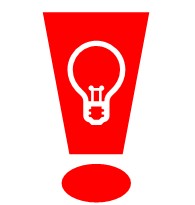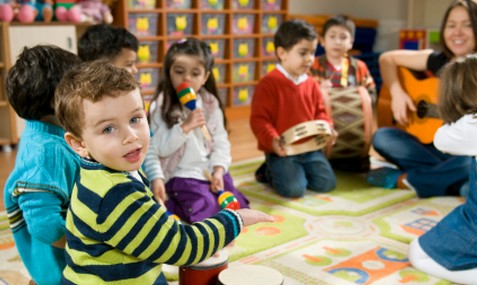I teach a class called Family Inventors’ Lab. The shortest way to describe the class is “STEM Enrichment for ages 3 – 7.” But if I describe it that way, and then mention that we do a rhythm activity to open every group time, and that we teach a new theme-related song every week, some folks will ask how music fits in to STEM.
STE(A)M
First, let’s broaden out STEM to STEAM – Science, Technology, Engineering, ARTS, and Math. Not only do we include music, we also include other arts: painting, sculpting, collage, print-making, plenty of opportunity for imagination / dramatic play, and a fictional story designed to inspire the imagination. If we’re raising the “inventors of tomorrow”, then imagination and creativity are just as important as knowledge of science facts and mastery of science process skills.
Music and academic skills
Second, let’s talk about rhythm and music and how they help kids to learn academic skills.
- Language – beat, rhythm and pitch are all a part of language, so music and rhythm activities help a child develop speech, communication and language skills.
- Auditory processing – music lessons help kids respond to sound more quickly, distinguish between sounds better, and pay attention to sound, all of which aid in classroom learning.
- Memory – kids with musical training have better memories for words, lyrics, and numbers.
- Academic success – children do better on standardized tests and in school performance.
As a comprehensive learning experience, we want to give our students some music exposure to get a small dose of these benefits.
You can see the details of the research here. And learn more about the benefits of music in this post.
Rhythm and motor skills
Third, let’s talk about how rhythm helps kids learn how to use their bodies effectively.
When we use our bodies well, we have rhythm – we walk in rhythm, chew in rhythm, and breathe in an even rhythm. Rhythm helps with playing an instrument, dancing, jumping rope, rowing a boat, or bouncing a ball. It helps us to speak in conversational rhythm without stuttering. When we use tools with our bodies, it helps to have rhythm – when we hammer, use a saw, beat eggs with a whisk, cut with scissors, typing on a keyboard, and many other tasks work better when you’ve got an even rhythm. So, the rhythm ties into the T in STEM – T for Technology and for Tools.
The ability to keep a steady beat is not completely instinctive. (Source) It is something we need to learn.
“One study revealed that fewer than 10% of kindergarten children could independently feel and express the steady beat of recorded music (Wright & Schweinhart, 1994). Fewer than 15% of first graders tested had this ability (Mitchell, 1994). Fewer than 50% of the children in grades 4 through 6 could walk to the steady beat of a musical selection (Kiger, 1994).” (Source)
Ideally, all children would be able to keep a steady beat by age 3, and the best time to teach it is before age 7. (Source)
We learn a steady beat by using our bodies in rhythm – dancing, swaying, clapping, beating a drum, or using rhythm sticks all help us to learn about rhythm. So does swinging on a swing, rocking in a chair, going up and down on a teeter totter, or doing any activity that works better with rhythm. (See above for examples.)
Note: the Music Connections blog has some great resources on teaching rhythm to babies and toddlers.
Teaching Tool
Within the rhythm of our class, music serves many roles.
- Signals transitions. We change our activities each week, to provide as many novel experiences as possible. However, we also know that young children thrive on routine, so we try to keep some of the core structure of the class consistent from week to week. We sing the same songs each week to signal this routine – “It’s time to make a circle…”
- Gathers attention. At the start of group time, the kids can be really scattered. Doing a rhythm activity together helps them to center themselves, get focused on the teacher, and let go of other distractions.
- Reinforces key ideas and increases retention. We have a science themed song each week. Many, though not all, of our songs help to reinforce key ideas about the topic we are learning (such as the States of Matter song, or the Simple Machines song), and some help apply and remember ideas (like the Habitat Song and the Rainbow Song.) At the end of the year, we reprised some of the songs we had learned, and it was fascinating to see how many the kids remembered.
- Fun. Many of our songs are just fun to sing, and make us all happy – parents, teachers, and kids. We know the kids learn more when they’re happy.


[…] Music and STEM Learning […]
LikeLike
[…] Also, be sure they have musical instruments to play with, especially rhythm instruments. (Learn more about how music helps kids learn STEM.) […]
LikeLike
[…] Songs: We teach 1 – 3 theme related songs or rhythm activities each week. (Learn here about the benefits of incorporating music in STEM) […]
LikeLike
[…] kids learn and remember the science concepts that we are teaching. (There are also lots of other benefits to using music in a STEM class.) You can find all our songs about science and inventors here. Our songs come from many sources: […]
LikeLike
[…] observation activities, art projects, sensory play in the water table, dramatic play, stories, and songs to reinforce the key ideas about science tools, science process skills and the scientific method. [Note: many […]
LikeLike
[…] Also, be sure they have musical instruments to play with, especially rhythm instruments. (Learn more about how music helps kids learn STEM.) […]
LikeLike
[…] surprised to hear that we include music in a STEM class, then I encourage you to read my post on Music and STEM Learning which covers how music reinforces rhythm which relates to math learning, how music helps with […]
LikeLike
[…] Also, be sure they have musical instruments to play with, especially rhythm instruments. (Learn more about how music helps kids learn STEM.) […]
LikeLike